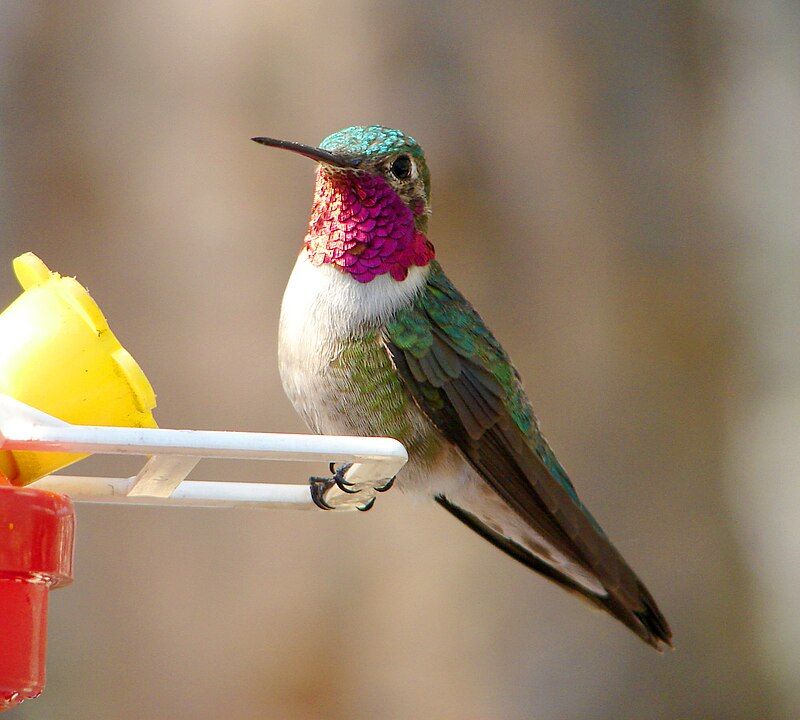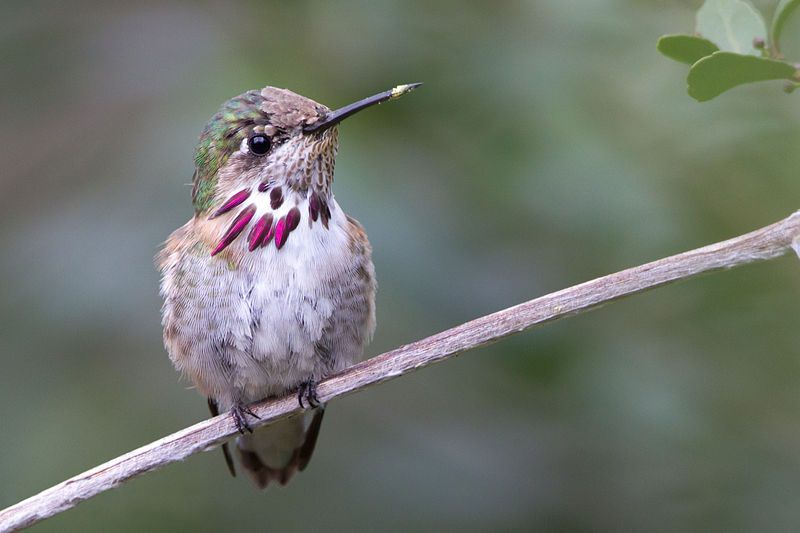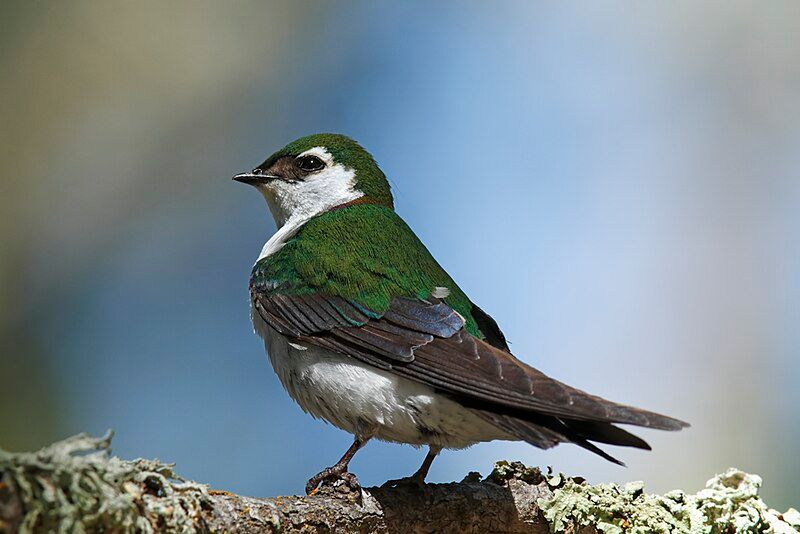Welcome to the world of green birds in New Mexico! New Mexico is full of exciting and unique species for birders. Among the many colorful birds found in New Mexico, the green birds stand out as some of the most stunning.
From the vibrant and beautiful parrots of the Rio Grande Valley to the tiny, electric-green hummingbirds of the Chihuahuan Desert, there are plenty of green birds to find in New Mexico.
Whether you’re a beginner birdwatcher or a seasoned veteran, exploring the green birds of New Mexico is sure to be an exhilarating and rewarding experience.
12 Green Birds in New Mexico
If you are a bird lover, you might be interested in learning about 12 green birds found in New Mexico. New Mexico has diverse habitats, from deserts and mountains to forests and wetlands.
Here are 12 of these green birds.
1. Green Heron
The green heron (Butorides virescens) is a small heron in North and Central America. The name of this species is derived from two sources: Middle English butor, meaning “bittern,” and Ancient Greek -rides, meaning “resembling.”
The word virescens is Latin for “greenish,” which reflects the overall coloration of the species. The green heron is a medium-sized bird with a wingspan of 24–30 inches and a body length of 17–22 inches. It has a long neck and a long pointy bill.
It typically has a dark chestnut neck, a greenish-black head and back, and a greyish-white underside.
It also has yellow eyes, a yellowish-green bill, and a reddish-brown breast. The green heron lives in wetlands and shallow lakes, feeding on small fish, crustaceans, aquatic insects, and even small reptiles.
This species often hunts by standing still in shallow water and waiting for its prey to swim by. It then uses its long neck and bill to snatch its prey. The green heron is a solitary species rarely seen in large flocks.
It is an elusive bird and prefers to remain hidden in thick vegetation. Breeding usually occurs between April and August. During this time, pairs of herons will build their nest in tall trees or shrubs.
The female typically lays three to four eggs, and the hatchlings will fledge after about five weeks. The green heron is a beautiful and fascinating bird that plays a vital role in controlling the populations of small aquatic species.
Despite its small size, it has a significant presence in North and Central America and can be found in various wetlands and other aquatic habitats.
| Kingdom | Animalia |
| Phylum | Chordata |
| Clade | Dinosauria |
| Class | Aves |
| Order | Pelecaniformes |
| Family | Ardeidae |
| Genus | Butorides |
| Species | B. virescens |
2. Anna’s Hummingbird
Anna’s hummingbird is a species found in North America and named after Anna Masséna, Duchess of Rivoli. It is native to western coastal regions of North America, stretching from northern Baja California to Southern California.
In the early 20th century, Anna’s hummingbirds were found only in these two regions but have since spread their range further north. They are most commonly found in gardens, yards, and other areas with flowers, where they feed on nectar and insects.
The males are a striking green with a dark head and throat, while the females are a duller green with a white throat. They are smaller than other hummingbirds, measuring only up to 3.5 inches long. Anna’s hummingbirds are known for their rapid, hovering flight and loud chirping.
They are often seen hovering in front of flowers, drinking the nectar. They also use their long, curved beaks to catch insects in midair.
| Kingdom | Animalia |
| Phylum | Chordata |
| Clade | Strisores |
| Class | Aves |
| Order | Apodiformes |
| Family | Trochilidae |
| Genus | Calypte |
| Species | C. anna |
3. Broad-Tailed Hummingbird

The broad-tailed hummingbird is a medium-sized hummingbird found in highland regions from the western United States, western Canada, Mexico, and Guatemala.
This hummingbird is known for its unique, broad, forked tail and loud and high-pitched call. It typically measures between 3 and 4 inches long and has a wingspan of about 4.5 inches.
The male of the species is primarily green, with a bright, iridescent red throat patch and a black chin and upper breast.
The female is primarily greenish-brown with a duller throat patch and a white chin and upper breast. The broad-tailed hummingbird is commonly found in mountain pine forests, canyons, and chaparral habitats, as well as in gardens and yards.
It typically feeds on nectar from various flowers, small insects, and spiders. During the breeding season, the male of the species can often be seen performing spectacular courtship displays in the air, with dives, spiraling ascents, and hovering.
The female builds a small cup nest and lays two eggs, which are incubated for about 14 days before hatching. The broad-tailed hummingbird is an integral part of the highland ecosystems of western North America and is a crucial pollinator for many plant species in the region.
It is listed as a species of most minor concern on the International Union for Conservation of Nature’s Red List. Still, its population has been steadily declining due to habitat loss and other threats.
| Kingdom | Animalia |
| Phylum | Chordata |
| Clade | Strisores |
| Class | Aves |
| Order | Apodiformes |
| Family | Trochilidae |
| Genus | Selasphorus |
| Species | S. platycercus |
4. Calliope Hummingbird

The Calliope Hummingbird is the smallest bird native to the United States and Canada and is found in various habitats across the region.
During the summer months, its western breeding range extends mainly from California to British Columbia, while during the winter months, it migrates south to the Southwestern United States, Mexico, and Central America.
This hummingbird species is relatively small, typically measuring between three and four inches in length, and has distinctive plumage, usually consisting of a bronze-green back, white breast, and a long, deeply forked tail.
The Calliope Hummingbird feeds mainly on nectar from flowers and is highly adapted to foraging in this manner. It has a long, thin bill, ideally suited for probing deep into tubular flowers and extracting sweet nectar.
The hummingbird is also a skillful flyer, beating its wings up to 80 times per second to achieve its trademark hovering flight.
The Calliope Hummingbird is a fascinating species, and its yearly migration from its summer breeding grounds to the Southwestern United States, Mexico, and Central America is a testament to its hardiness and adaptability.
It is a species that I will continue to captivate birdwatchers and admirers for many years.
| Kingdom | Animalia |
| Phylum | Chordata |
| Clade | Strisores |
| Class | Aves |
| Order | Apodiformes |
| Family | Trochilidae |
| Genus | Selasphorus |
| Species | S. calliope |
5. New World Warblers
The New World warblers, or wood-warblers, are a group of small, brightly-colored passerine birds. These birds comprise the Parulidae family and are only found in the New World. The New World warblers are not closely related to the Old World or Australian warblers.
The different characteristics and behaviors set them apart from the other warbler families. For example, the New World warblers typically have more distinct colors, such as yellow, orange, and blue, than Old World and Australian warblers.
Additionally, they tend to be more active during the day and have more varied song repertoires than their Old World counterparts.
Unlike the Old World warblers, which have a more widespread range and are found on more continents, the New World warblers are primarily found in North and South America.
The New World warblers have adapted to various habitats, from rainforest to desert, and can be found from sea level to the high mountains. The New World warblers are a diverse group of birds and are an essential part of the avian ecology of the New World.
They provide food for predators, pollinate plants, and disperse seeds, thus helping to maintain the balance of the environment. They are also important indicators of a healthy ecosystem, as their presence in an area often indicates a healthy habitat.
| Kingdom | Animalia |
| Phylum | Chordata |
| Clade | Dinosauria |
| Class | Aves |
| Order | Passeriformes |
| Family | Parulidae |
6. MacGillivray’s Warbler
MacGillivray’s warbler is a species of small songbird from the New World. These birds are usually found in open forests and woodlands and are recognizable by their thick, yellowish-green bill and olive-green plumage.
They are larger than other warbler species and generally have a slower, more sluggish flying style. They can usually be seen foraging along the ground rather than high up in the trees, and they tend to avoid open areas and dense shrubbery.
This is likely because they prefer to spend most of their time near the ground, where they can find plenty of insect prey. The only time whey can be seen high up in the trees is when they are
During the breeding season, male MacGillivray’s warblers will perch in the canopy and sing their loud, melodious song to attract a mate. After mating, they will return to the ground to forage and nest.
Overall, MacGillivray’s warbler is a unique species of New World warbler, with its preference for foraging on or near the ground and its tendency to sing from high up in the trees.
| Kingdom | Animalia |
| Phylum | Chordata |
| Clade | Dinosauria |
| Class | Aves |
| Order | Passeriformes |
| Family | Parulidae |
| Genus | Geothlypis |
| Species | G. tolmiei |
7. Ovenbird
The Ovenbird is a small songbird belonging to the New World warbler family. It is a migratory bird, breeding in eastern North America and wintering in Central America, several Caribbean islands, Florida, and northern Venezuela.
It is a common sight in the warmer months, as it prefers to nest in deciduous woodland areas. The Ovenbird is unique in that it builds its nest in the shape of an oven, which is why it was given its name.
Its nest is a circular structure made of grass and leaves, with an entrance hole at the side. The interior is lined with feathers, fur, and moss. During the breeding season, the male will sing a loud, repeated song, often used to attract females.
The OOvenbird’sdiet consists mainly of insects but will also feed on seeds and berries. During the winter months, it can be seen foraging in flocks. It is primarily a ground feeder but will occasionally feed in trees.
The Ovenbird is an essential species for conserving the New World Warbler family. According to the International Union for Conservation of Nature (IUCN), it is a species of most minor concern. Still, its population is declining due to habitat loss and degradation.
It is essential to protect and maintain its habitats to ensure the species’ long-term survival.
| Kingdom | Animalia |
| Phylum | Chordata |
| Clade | Dinosauria |
| Class | Aves |
| Order | Passeriformes |
| Family | Parulidae |
| Genus | Seiurus |
| Species | S. aurocapilla |
8. Lesser Goldfinch
The lesser goldfinch is a species of small songbird found in the Americas. It is closely related to two other species of goldfinch, the American goldfinch and Lawrence’s goldfinch, and together they form the New World goldfinch clade.
This clade belongs to the genus Spinus. The males of all three species of New World goldfinch have a black forehead, which is absent in the females of the species.
This identifying feature of the lesser goldfinch can be used to tell them apart from the other two species. The black forehead, along with other distinguishing features, helps to ensure that the lesser goldfinch is not mistaken for the other two species.
| Kingdom | Animalia |
| Phylum | Chordata |
| Clade | Dinosauria |
| Class | Aves |
| Order | Passeriformes |
| Family | Fringillidae |
| Genus | Spinus |
| Species | S. psaltria |
9. Violet-Green Swallow

The violet-green swallow is a small bird from the swallow family found in North America. It is an aerial insectivore, meaning it feeds on insects in the air.
This bird is distributed on the west coast of North America from Alaska in the north to Mexico in the south, as well as in some parts of the east coast, such as Montana and Texas.
It is a widespread bird in these areas and is often seen in parks, forests, and other natural areas. Its plumage is mainly grayish and has a forked tail, which helps it maneuver through the air.
The violet-green swallow is an integral part of the local ecology as it helps control insect populations.
| Kingdom | Animalia |
| Phylum | Chordata |
| Clade | Dinosauria |
| Class | Aves |
| Order | Passeriformes |
| Family | Hirundinidae |
| Genus | Tachycineta |
| Species | T. thalassina |
10. Painted Bunting
The painted bunting is a vibrant bird species belonging to the family Cardinalidae. Native to North America, these birds are known for their beautiful plumage; however, it takes two years for the males to develop their stunning colors.
During their first year, the males and females can be difficult to distinguish from one another, requiring close observation to spot the subtle differences.
The combination of the painted bunting’s vibrant colors and the delay in their development made these birds a beloved species among birdwatchers and ornithologists.
| Kingdom | Animalia |
| Phylum | Chordata |
| Clade | Dinosauria |
| Class | Aves |
| Order | Passeriformes |
| Family | Cardinalidae |
| Genus | Passerina |
| Species | P. ciris |
11. Mexican Violetear
The Mexican violetear is a hummingbird species found in forested areas from Mexico to Nicaragua. It is a medium-sized bird with a metallic green coloration. This species was previously combined with the lesser violetear and was called green violetear.
Both species were considered the same species or conspecific. However, recent studies have shown that they are two distinct species and can be distinguished by their size and coloration.
The Mexican violetear is larger than the lesser violetear, and its body is a more vibrant and metallic green. The lesser violetear is smaller, and its body is a duller green.
Both species are found in similar habitats, but the Mexican violetear is more widespread and can be found in more significant numbers.
| Kingdom | Animalia |
| Phylum | Chordata |
| Clade | Strisores |
| Class | Aves |
| Order | Apodiformes |
| Family | Trochilidae |
| Genus | Colibri |
| Species | C. thalassinus |
12. Berylline Hummingbird
The berylline hummingbird is a species of hummingbird belonging to the “emeralds” tribe Trochilini of the Trochilinae subfamily. This hummingbird species is native to several American countries, including El Salvador, Guatemala, Honduras, Mexico, and the United States.
It is a small bird, measuring between 10 and 12 cm in length, with a short, straight bill and a long, forked tail, and is characterized by its bright green head and breast, blackish wings and tail, and bright red throat and crown.
It is an active bird, often seen in gardens and parks where it feeds on nectar from flowers. The berylline hummingbird is also an important pollinator, helping to spread the pollen of many flowering plants.
It is an iconic species, and its presence in the Americas is an essential indication of the overall health of the region’s ecosystems.
| Kingdom | Animalia |
| Phylum | Chordata |
| Clade | Strisores |
| Class | Aves |
| Order | Apodiformes |
| Family | Trochilidae |
| Genus | Saucerottia |
| Species | S. beryllina |
Conclusion
The sighting of 12 green birds in New Mexico is a remarkable event that prompts further exploration into avian migration patterns, habitat preferences, and ecological impacts.
This observation underscores the importance of citizen science initiatives in monitoring and understanding biodiversity shifts.
As we continue to uncover such phenomena, it emphasizes the need for proactive conservation measures to safeguard the habitats and species that enrich our natural world.